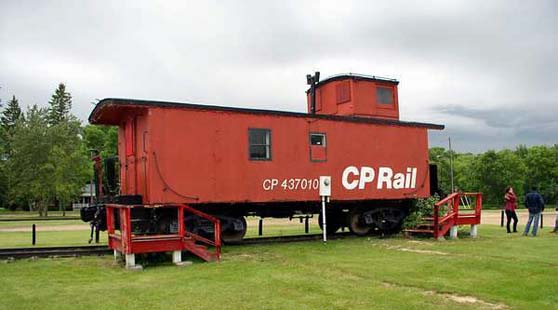

A standard Canadian Pacific Railway wood caboose at Winnipeg Beach, Manitoba, rests
on the former station property and serves to remind everyone of the role CPR played in the areas development. |
17 May 2011
Under the Boardwalk
Winnipeg Beach Manitoba - In 1901, the Canadian Pacific Railway purchased 330 acres of the west shore of Lake Winnipeg for $3,000 and
announced it was building a resort area known as Winnipeg Beach.
It would prove "a splendid resort for the toilers of the capital, who are in badly need of a place within easy reach, where they can take a day's outing
and enjoy the health-giving breeze from Lake Winnipeg," CPR vice-president William Whyte told an interviewer.
And it was. Within a few years, there were 13 trains running the line to and from Winnipeg Beach on busy weekends. There were the picnic trains for church and
community groups, the Daddy's Train for commuting businessmen, and the Moonlight Special for... well, let's just say a healthy breeze wasn't the only thing
that drew 40,000 visitors a day to Winnipeg Beach during its peak in the 1920s.
According to the author of a new book that charts the rise and fall of Manitoba's first beach resort, our "Coney Island of the West" was a
"centre for courtship" that played a surprising role in a sexual revolution of sorts.
"The boardwalk's bright lights provided a moral security to the area, but there was darkness in this summertime adventure, whether in the areas beyond the
boardwalk, the inky darkness of the beach, or the darkness created when male passengers on the Moonlight train extinguished the lights," Dale Barbour
writes in "Winnipeg Beach: Leisure and Courtship in a Resort Town, 1900-1967". He'll launch the book Wednesday at 7 p.m. at McNally Robinson
Booksellers.
The Moonlight Special, which departed Winnipeg every evening at 6:45 p.m., returning to the city at 12:45 a.m., became synonymous with the dating experience.
"There's definitely a mythology around it," Barbour says. "It had a bit of a reputation for being a bit naughty."
Val Werier, 93, recalls the 70-minute trek back to the city at 12:45 "could be quite boisterous at times."
Turning the lights off inside the train on the ride home created a symbolic, and very real, moment of freedom for the youthful passengers, Barbour explains in
the book.
Remember, Winnipeg Beach flourished in the early part of the 20th century, when swimsuits stretched from shoulders to knees and "calling" was the
established form of courtship.
About the Beach
By 1906, Winnipeg Beach was so popular that CPR was running 13 trains a day to and from the city. During its heyday, the Winnipeg Beach line was hailed as the
most profitable stretch of CPR track in Canada.
Round-trip fare for the 70-minute ride was $1.20, at time when an early 20th-century labourer's salary was 25 cents an hour and a skilled tradesman's 65 cents
an hour.
Round-trip fare on the MoonLight Special, which ran for 50 years, was only 50 cents.
The dance hall, which boasted a 14,000-square-foot dance floor, was Western Canada's largest at the time.
In 1928, Winnipeg Beach was home to Manitoba's only women's beer parlour, which lasted just a few hours before being closed down over licensing issues. The
men's-only beer parlour operated into the early 1960s.
In 1943, town council passed a bylaw requiring persons over the age of 12 "be clad from shoulders to knees" while in public spaces.
Carolin Vesely. (abridged)

|
